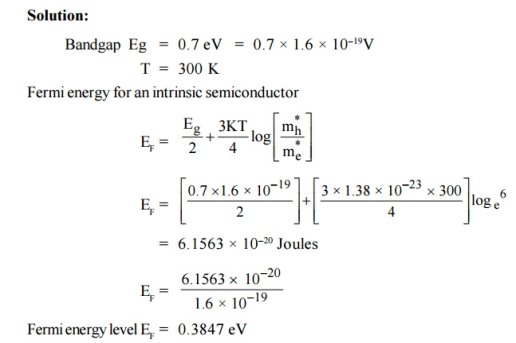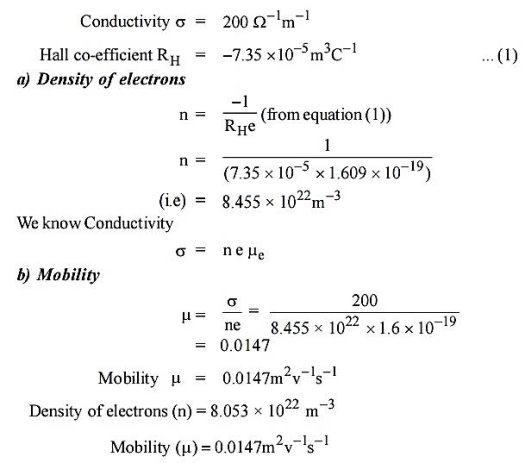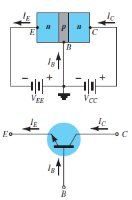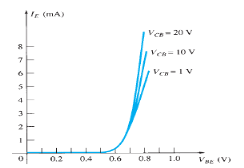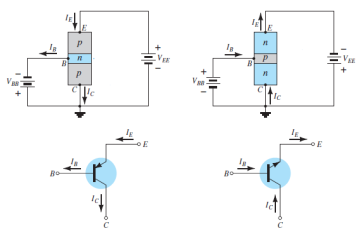|
|
|
Integrating across the depletion region gives
…………… (2) Under equilibrium conditions.
Solving for ξ in equation (3) and making use of the Einstein relationship. We obtain Substituting Equation (4) into Equation (2), and completing the integration then yields …………… (5) For the specific case of a non-degenerately doped step junction where ND and NA are the n- and p-side doping concentrations, one denies. and therefore
It is useful to perform a sample computation to gauge the relative magnitude of the built in voltage. Choosing ND= NA = 1015/ cm3 and a Si diode maintained at 300 K, One computes Vbi= (0.0259) ln(1030/1020) From the energy band diagram, we observed
Clearly, for a Non-degenerately doped diode bosh (Ei — EF) p-side, and (EF — Ei) n-side are less than EG/2, making Vbi < EG/q Moreover, in a Non-degenerately doped step junction under equilibrium conditions,
|
 Where KB Boltzmann Constant T Temperature If g(E) is the density of states and f(E) gives the probability of occupation of those states at a given temperature, the number of occupied states, n(E), is given by n(E) =
Where KB Boltzmann Constant T Temperature If g(E) is the density of states and f(E) gives the probability of occupation of those states at a given temperature, the number of occupied states, n(E), is given by n(E) =  (1) If the number of occupied states in an energy band needs to be calculated the integration needs to be performed over the entire band. This will be a function of temperature, since the Fermi function is temperature dependent. Equation 1 can be used to calculate the concentration of electron and holes in semiconductors, which decides their conductivity.Effect of temperature on Fermi Function:Case (i) Probability of occupation for E < EF at T = 0K
(1) If the number of occupied states in an energy band needs to be calculated the integration needs to be performed over the entire band. This will be a function of temperature, since the Fermi function is temperature dependent. Equation 1 can be used to calculate the concentration of electron and holes in semiconductors, which decides their conductivity.Effect of temperature on Fermi Function:Case (i) Probability of occupation for E < EF at T = 0K When T = 0K and E < EF, we haveF(E) =
When T = 0K and E < EF, we haveF(E) =  =
=  = 1Thus at T = 0K, there is 100 % chance for the electrons to occupy the energy levels below the Fermi level.
= 1Thus at T = 0K, there is 100 % chance for the electrons to occupy the energy levels below the Fermi level.
|
 =
=  =
=  = 0Thus, there is 0 % chance for the electrons to occupy energy levels above the Fermi energy level. From the above two cases, at T = 0K the variation of F(E) for different energy values becomes a step function.Case (iii) Probability of occupation at ordinary temperatureAt ordinary temperature, the value of probability starts reducing from 1 for values of E slightly less than EF. With the increase of temperature, i.e., T> 0K, Fermi function F (E) varies with E. At any temperature other than 0K and E = EFF(E) =
= 0Thus, there is 0 % chance for the electrons to occupy energy levels above the Fermi energy level. From the above two cases, at T = 0K the variation of F(E) for different energy values becomes a step function.Case (iii) Probability of occupation at ordinary temperatureAt ordinary temperature, the value of probability starts reducing from 1 for values of E slightly less than EF. With the increase of temperature, i.e., T> 0K, Fermi function F (E) varies with E. At any temperature other than 0K and E = EFF(E) =  =
=  =
=  = 50%Hence, there is 50 % chance for the electrons to occupy Fermi level. Further, for E > EF the probability value falls off rapidly to zero. Case (iv) At high temperatureWhen kT >> EF, the electrons lose their quantum mechanical character and Fermi distribution function reduces to classical Boltzmann distribution Q6) Explain Fermi level for intrinsic semiconductors and what is the effect of temperature on Fermi level?A 6)Fermi LevelWe know that in intrinsic semiconductor Electron concentration ‘n’ = Hole concentration ‘p’ Equating Equations (15) and (27), we get
= 50%Hence, there is 50 % chance for the electrons to occupy Fermi level. Further, for E > EF the probability value falls off rapidly to zero. Case (iv) At high temperatureWhen kT >> EF, the electrons lose their quantum mechanical character and Fermi distribution function reduces to classical Boltzmann distribution Q6) Explain Fermi level for intrinsic semiconductors and what is the effect of temperature on Fermi level?A 6)Fermi LevelWe know that in intrinsic semiconductor Electron concentration ‘n’ = Hole concentration ‘p’ Equating Equations (15) and (27), we get
Taking logarithms on both sides, we get
|
 is very small so that EF is just lie in the middle of energy gap Temperature effect on Fermi levelFermi level slightly rises with increase of temperature.But in case of pure intrinsic semiconductor like Si and Ge, mh* ≈ me* so in these cases Fermi level lies at the middle of energy gap.Q7) Derive expression for carrier concentration for intrinsic semiconductors? A 7)Intrinsic semiconductors—carrier concentrationHere we will calculate the number of electrons excited into conduction band at temperature T and also the hole concentration in the valence band. It is assumed that the electrons in the conduction band behave as if they are free particles with effective mass me* and the holes near the top of the valence band behave as if they are free particles with effective mass mh*. Here we will calculate the electron concentration, hole concentrationDensity of Electrons in Conduction BandThe number of free electrons per unit volume of semiconductor having energies in between E and E + dE is represented as N(E) dE dE = width of Energy bandTherefore, we have:N(E) dE = ge(E) dE fe (E) ………. (1) ge(E) = The density of electron states per unit volumefe(E) = Fermi-Dirac distribution function i.e. probability that an electron occupies an electron stateThe number of electrons present in the conduction band per unit volume of material ‘n’ is obtained by integrating N(E) dE between the limits Ec and Ect Where Ec = the bottom energy levels of conduction band
is very small so that EF is just lie in the middle of energy gap Temperature effect on Fermi levelFermi level slightly rises with increase of temperature.But in case of pure intrinsic semiconductor like Si and Ge, mh* ≈ me* so in these cases Fermi level lies at the middle of energy gap.Q7) Derive expression for carrier concentration for intrinsic semiconductors? A 7)Intrinsic semiconductors—carrier concentrationHere we will calculate the number of electrons excited into conduction band at temperature T and also the hole concentration in the valence band. It is assumed that the electrons in the conduction band behave as if they are free particles with effective mass me* and the holes near the top of the valence band behave as if they are free particles with effective mass mh*. Here we will calculate the electron concentration, hole concentrationDensity of Electrons in Conduction BandThe number of free electrons per unit volume of semiconductor having energies in between E and E + dE is represented as N(E) dE dE = width of Energy bandTherefore, we have:N(E) dE = ge(E) dE fe (E) ………. (1) ge(E) = The density of electron states per unit volumefe(E) = Fermi-Dirac distribution function i.e. probability that an electron occupies an electron stateThe number of electrons present in the conduction band per unit volume of material ‘n’ is obtained by integrating N(E) dE between the limits Ec and Ect Where Ec = the bottom energy levels of conduction bandEct = the bottom and top energy levels of conduction band n = can be written as n = n = we know that above Ect, there is no electrons. Hence, Equation (3) becomes n = n = The Fermi-Dirac distribution function fe(E) can be represented as:
Compared to the exponential value, so the ‘1’ in the denominator can be neglected. So Hence, The density of electron states ge(E) in the energy space from E = 0 to E can be written as:
where me* is the effective mass of an electron and h is Planck’s constant.
To evaluate n, the density of states is counted from Ec, since the minimum energy state in conduction band is Ec. so eq (8) can become
Substituting Equations (6) and (9) in (4) gives n = n = The above equation can be simplified by the following substitution: Put ɛ = E − Ec ………… (11) So, dɛ = dE In Equation (11), Ec is constant, as we change the variable E to ε in Equation (10), the integral limits also change. In Equation (11), as E → Ec then ε → 0 and E → ∞, then ε also → ∞. the exponential term in Equation (10) becomes:
Substituting Equations (11) and (12) in (10), we get: n = n = Above integral (I) can be simplified by substitution. Put ε = x2 so that dɛ = 2x dx I = = = Substituting Equation (14) in (13) gives: n = n = n = n = The term n =Nc Density of Holes in Valence Band The number of holes per unit volume of semiconductor in the energy range E and E + dE in valence band is represented as P(E) dE. Proceeding same way (as in case of electrons) we have Therefore, we have: P(E) dE = gh(E) dE fh(E) ………. (17) dE = width of Energy band gh(E) = The density of holes’ states per unit volume fh(E) = Fermi-Dirac distribution function i.e. probability that a hole occupies an electron state The number of electrons present in the conduction band per unit volume of material ‘n’ is obtained by integrating P(E) dE between the limits Evb and EV where EV = the bottom energy levels of valence band Evb = the bottom and top energy levels of valence band The total number of holes present in the valence band per unit volume of material ‘p’ is obtained by integrating P(E) dE
Equation (18) can be represented as:
Now we know that below Evb no holes are present. Hence, Equation (19) becomes
We know hole can also be defined as absence of an electron. presence of a hole = the absence of an electron Hence, the Fermi-Dirac function of holes fh(E) in the valence band is:
Compared to exponential, the ‘1’ in the denominator is negligible, Hence,
The density of hole states between E and E + dE in valence band can be written similar to Equation (8.9) for electrons.
Where mh* is the effective mass of hole. Substituting Equations (21) and (22) in (20),
The above equation can be simplified by the substitution: Put ɛ = EV − E ............. (24) so dɛ = − dE In Equation (24), EV is constant, as we change the variable E to ε in Equation (23), the integral limits also change. In Equation (24), as E → EV then ε → 0 and E→ −∞, then ε → ∞ the exponential term in Equation (23) becomes:
Substituting Equations (24) and (25) in (23), we get:
From Equation (14), we know the integral value
….The term
|
concentration of acceptor ions N−A = acceptor concentration x probability of finding an electron in acceptor level
Similarly, the donor ions concentration is
|
|
 …………..(40)where pn represents holes concentration in n-type material. In n-type material at 0 K, the Fermi energy level lies in the middle of Ec and ED
…………..(40)where pn represents holes concentration in n-type material. In n-type material at 0 K, the Fermi energy level lies in the middle of Ec and ED  At temperature> 0K
At temperature> 0K  ……….(41)With increase in temperature the Fermi level shifts upwards according to Equation (61) slightly due to ionization of donor atoms. With further increase of temperature, electron-hole pairs are generated due to the breaking of covalent bonds, hence Fermi level shifts downwards.In p-type semiconductorNote pp represents holes in p-type materialnp represents electrons in p-type materialThere are no donor atoms so means no ions present
……….(41)With increase in temperature the Fermi level shifts upwards according to Equation (61) slightly due to ionization of donor atoms. With further increase of temperature, electron-hole pairs are generated due to the breaking of covalent bonds, hence Fermi level shifts downwards.In p-type semiconductorNote pp represents holes in p-type materialnp represents electrons in p-type materialThere are no donor atoms so means no ions present  = 0. At 0 K, all the acceptor levels are not occupied by electrons. As the temperature is increased from 0 K, some electrons jump from top valence band energy levels to the acceptor states, leaving holes in the valence band and acceptor ions
= 0. At 0 K, all the acceptor levels are not occupied by electrons. As the temperature is increased from 0 K, some electrons jump from top valence band energy levels to the acceptor states, leaving holes in the valence band and acceptor ions  are formed. At some room temperature T K, concentration of conduction electrons is extremely less compared with hole concentration.∴ From Equation (34), we have n + N−A = p ……………(42)(or) N−A ≈ p ……………. (43) [since n << N−A]At temperature T K, in p-type material, the hole concentration is almost equal to the acceptor atoms in unit volume of the material. So, Equation (43) can be written aspp ≈ NA ……………….(44)where pp represents holes in p-type materialThe electron concentration in p-type material can be obtained by applying law of mass action as nppp = ni2
are formed. At some room temperature T K, concentration of conduction electrons is extremely less compared with hole concentration.∴ From Equation (34), we have n + N−A = p ……………(42)(or) N−A ≈ p ……………. (43) [since n << N−A]At temperature T K, in p-type material, the hole concentration is almost equal to the acceptor atoms in unit volume of the material. So, Equation (43) can be written aspp ≈ NA ……………….(44)where pp represents holes in p-type materialThe electron concentration in p-type material can be obtained by applying law of mass action as nppp = ni2 …………….(45)where np represent free electron concentration in p-type material.
…………….(45)where np represent free electron concentration in p-type material.
|
 As the temperature is increased from 0 K, the Fermi level shifts downwards slightly as per Equation (46) due to ionization of acceptor atoms. And with further increase of temperature, electron-hole pairs are generated due to the breaking of covalent bonds, so Fermi level shifts upwards.Q 9) Derive hall coefficient? Show how hall coefficient and mobility are related? A 9)When the magnetic field is applied perpendicular to a current-carrying conductor, then a voltage is developed in the material perpendicular to both the magnetic field and current in the conductor. This effect is known as Hall Effect and the voltage developed is known as Hall voltage (VH). Hall Effect is useful to identify the nature of charge carriers in material and hence to decide whether the material is an n-type semiconductor or p-type semiconductor, also to calculate carrier concentration and mobility of carriers.Hall Effect can be explained by considering a rectangular block of an extrinsic semiconductor in which current is flowing along the positive X-direction and magnetic field B is applied along Z-direction as shown in Figure.
As the temperature is increased from 0 K, the Fermi level shifts downwards slightly as per Equation (46) due to ionization of acceptor atoms. And with further increase of temperature, electron-hole pairs are generated due to the breaking of covalent bonds, so Fermi level shifts upwards.Q 9) Derive hall coefficient? Show how hall coefficient and mobility are related? A 9)When the magnetic field is applied perpendicular to a current-carrying conductor, then a voltage is developed in the material perpendicular to both the magnetic field and current in the conductor. This effect is known as Hall Effect and the voltage developed is known as Hall voltage (VH). Hall Effect is useful to identify the nature of charge carriers in material and hence to decide whether the material is an n-type semiconductor or p-type semiconductor, also to calculate carrier concentration and mobility of carriers.Hall Effect can be explained by considering a rectangular block of an extrinsic semiconductor in which current is flowing along the positive X-direction and magnetic field B is applied along Z-direction as shown in Figure.
|
 ……………..(4)In n-type material, Jx = –nevdvd = -
……………..(4)In n-type material, Jx = –nevdvd = -  ……………..(5)Where n is free electron concentration, substituting (5) in (3), we have ∴ EH = -B
……………..(5)Where n is free electron concentration, substituting (5) in (3), we have ∴ EH = -B  ……………..(6)For a given semiconductor, the Hall field EH is proportional to the current density Jx and the intensity of magnetic field ‘B’ in the material.i.e. EH ∝ JxB(or) EH = RHJxB ……………..(7)Where RH = Hall coefficientEquations (6) and (7) are the same so, we haveRHJxB =-B
……………..(6)For a given semiconductor, the Hall field EH is proportional to the current density Jx and the intensity of magnetic field ‘B’ in the material.i.e. EH ∝ JxB(or) EH = RHJxB ……………..(7)Where RH = Hall coefficientEquations (6) and (7) are the same so, we haveRHJxB =-B  RH = -
RH = -  = -
= -  ……………..(8)Where ρ is the charge density Similarly for p-type materialRH =
……………..(8)Where ρ is the charge density Similarly for p-type materialRH =  =
= ……………..(9)Using Equations (8) and (9), carrier concentration can be determined.Thus, the Hall coefficient is negative for n-type material. In n-type material, as the more negative charge is deposited at the bottom surface, so the top face acquires positive polarity and the Hall field is along negative Y-direction. The polarity at the top and bottom faces can be measured by applying probes. Similarly, in the case of p-type material, a more positive charge is deposited at the bottom surface. So, the top face acquires negative polarity and the Hall field is along positive Y-direction. Thus, the sign of the Hall coefficient decides the nature of (n-type or p-type) material. The Hall coefficient can be determined experimentally in the following way:Multiplying Equation (7) with ‘d’, we haveEHd = VH = RHJxBd ……………..(10)From (Figure 15) we know the current density JxJx =
……………..(9)Using Equations (8) and (9), carrier concentration can be determined.Thus, the Hall coefficient is negative for n-type material. In n-type material, as the more negative charge is deposited at the bottom surface, so the top face acquires positive polarity and the Hall field is along negative Y-direction. The polarity at the top and bottom faces can be measured by applying probes. Similarly, in the case of p-type material, a more positive charge is deposited at the bottom surface. So, the top face acquires negative polarity and the Hall field is along positive Y-direction. Thus, the sign of the Hall coefficient decides the nature of (n-type or p-type) material. The Hall coefficient can be determined experimentally in the following way:Multiplying Equation (7) with ‘d’, we haveEHd = VH = RHJxBd ……………..(10)From (Figure 15) we know the current density JxJx =  Where W is the width of the box. Then, Equation (10) becomesVH = RH
Where W is the width of the box. Then, Equation (10) becomesVH = RH Bd = RH
Bd = RH RH =
RH =  ……………..(11)Substituting the measured values of VH, Ix, B, and W in Equation(11), RH is obtained. The polarity of VH will be the opposite for n- and p-type semiconductors.The mobility of charge carriers can be found by using the Hall effect, for example, the conductivity of electrons isn = neμnOr we can rewrite it asμn =
……………..(11)Substituting the measured values of VH, Ix, B, and W in Equation(11), RH is obtained. The polarity of VH will be the opposite for n- and p-type semiconductors.The mobility of charge carriers can be found by using the Hall effect, for example, the conductivity of electrons isn = neμnOr we can rewrite it asμn =  =n RH ……………..(12)by using equation (11)μn = n
=n RH ……………..(12)by using equation (11)μn = n ……………..(13)Q10) Discuss the application of the Hall Effect?A 10)• Using magnetic flux leakage – To properly inspect items such as pipes or tubes, Hall Effect probes work with something called magnetic flux leakage. This is a way of testing such items, and being able to spot potential corrosion, erosion, or pitting. This is specifically used in steel items and can give important information about lifespan or safety.• Sensors to detect rotation speed – A Hall Effect probe can be used in bicycle wheels, speedometers in the automotive world, electronic types of ignition systems, and gear teeth.• Used to detected movement – You will often find a Hall Effect probe used in such items as Go-Kart controls, smartphones, paintball guns, or airsoft guns, as well as some GPS systems.• Ferrite Toroid Hall Effect current transducers – This is mainly used in electronic compasses, making use of the magnetic field to show direction.• Split-ring clamp-on sensors – These types of Hall Effect probes are used to test equipment without having to take the whole circuit board apart, e.g. complex items.• Analog multiplication – Anything which needs a power measurement, e.g. sensing, and is also used in small computers.• General power measurement – Any device which needs to be tested for its power input can be done by a Hall Effect probe.• Position and motion sensors – This is mainly used in a DC motor, often the brushless type.• The automotive world – Hall Effect probes are used widely in the automotive world, especially in fuel injection and ignition. Wheel rotation sensors also use Hall Effect probes, e.g. for anti-lock braking.
……………..(13)Q10) Discuss the application of the Hall Effect?A 10)• Using magnetic flux leakage – To properly inspect items such as pipes or tubes, Hall Effect probes work with something called magnetic flux leakage. This is a way of testing such items, and being able to spot potential corrosion, erosion, or pitting. This is specifically used in steel items and can give important information about lifespan or safety.• Sensors to detect rotation speed – A Hall Effect probe can be used in bicycle wheels, speedometers in the automotive world, electronic types of ignition systems, and gear teeth.• Used to detected movement – You will often find a Hall Effect probe used in such items as Go-Kart controls, smartphones, paintball guns, or airsoft guns, as well as some GPS systems.• Ferrite Toroid Hall Effect current transducers – This is mainly used in electronic compasses, making use of the magnetic field to show direction.• Split-ring clamp-on sensors – These types of Hall Effect probes are used to test equipment without having to take the whole circuit board apart, e.g. complex items.• Analog multiplication – Anything which needs a power measurement, e.g. sensing, and is also used in small computers.• General power measurement – Any device which needs to be tested for its power input can be done by a Hall Effect probe.• Position and motion sensors – This is mainly used in a DC motor, often the brushless type.• The automotive world – Hall Effect probes are used widely in the automotive world, especially in fuel injection and ignition. Wheel rotation sensors also use Hall Effect probes, e.g. for anti-lock braking.- For N-type, Hall coefficient RH= negative
- For P-type, Hall coefficient RH= Positive
 =n RH. Where 𝜎= electrical conductivity
=n RH. Where 𝜎= electrical conductivity
|
|
|
|
|
|
|
|
|
|
|
|
|
|
|
|
|
|
Sr.no | Parameter | CB | CE | CC |
1 | Common terminal betnI/p & o/p | Base | Emitter | collector |
2 | Input Current | IE | IB | IB |
3 | Output Current | IC | IC | IE |
4 | Current Gain |
|
| ɤ= |
5 | Input Vtg. | VEB | VBE | VBC |
6 | Output Vtg. | VCB | VCE | VCC |
